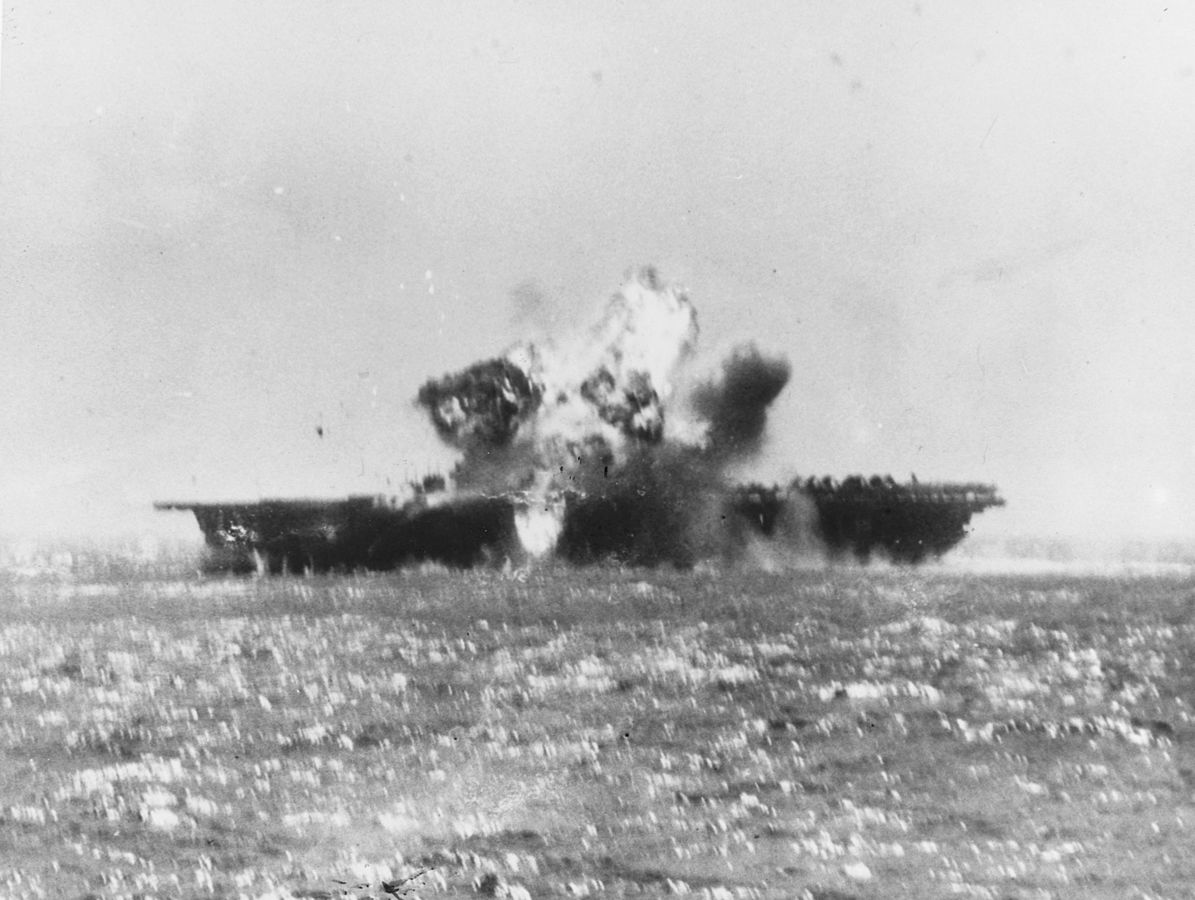World War II Terms to Know: Kamikaze
During the Pacific theater of World War II, Japan employed a grim yet iconic strategy: The kamikaze. These were suicide air attacks carried out by military pilots who crashed their aircraft into enemy ships — a tactic rooted in cultural ideals of honor sacrifice and, eventually, military desperation.
Most of the War in the Pacific following the attack on Pearl Harbor was fought with bombs, artillery shells, and bullets. But, in circumstances when it was deemed more important to inflict damage on the enemy than return home safely, they turned to the act of self-sacrifice known as kamikaze.
Kamikaze pilots were seen as early as the December 7, 1941 attack on Pearl Harbor. Though the suicide pilots of Japan were only organized into specific units later in the war, the concept of the kamikaze attack was a reflection of the Japanese idea that it was better to be killed in battle than captured.
What Is a Kamikaze Attack?

Kamikaze plane just before hitting USS Missouri (BB-63)
A kamikaze attack is a deliberate suicide mission carried out by Japanese pilots during World War II, where the aircraft is used as a guided missile to destroy Allied ships.
Before setting off, the specially-trained pilots would participate in a ceremony in which they shared ceremonial cups of sake (or water) known as mizu no sakazuki.
Kamikaze pilots were given military decorations and flew with prayers from their families. Once they took off, the planes were surrounded by fleet escorts that ensured the suicide craft made it to their target.
What Are The Origins of Kamikaze?
The term kamikaze originates from 13th-century Japan and was revived in WWII to name suicide missions carried out by pilots seeking to protect the homeland at all costs.
The word kamikaze was used to refer to the typhoons that thwartedMongolian invasion fleets. Roughly translated, it means “divine wind,” and originated from makurakotoba, figures of speech in Japanese poetry.
As Japan’s air power dwindled following the Battle of Midway, and experienced pilots became scarce, Captain Motoharu Okamura proposed using suicide attacks as an official strategy. The result was the formation of tokubetsu kōgekitai ("special attack units") — or kamikaze squadrons.
Before being used to describe suicide pilots of World War II, Kamikaze was the name of a Japanese monoplane that made a record-setting flight from Tokyo to London in 1937. This plane was the prototype for the Mitsubishi Ki-15 Babs, a reconnaissance plane used during the Second Sino-Japanese war.
Who Were Japan’s Kamikaze Pilots?
Kamikaze pilots were mostly young Japanese men, often barely trained, who were either ideologically motivated, pressured, or coerced into suicide missions against Allied forces.
Before taking off for the attack on Pearl Harbor, First Lieutenant Fusata Iida reportedly told his men that if his plane were to become damaged, he would direct it into a “worthy enemy target.” During the attack, after being struck by American anti-aircraft rounds, Iida steered his craft toward Naval Air Station Kaneohe and crashed it.
This may be the first recorded kamikaze attack of the war, though it was far from the last. Initially, Japanese pilots were simply too proud to let themselves be captured by the Allied forces. When their options were either to land were land in enemy territory and risk imprisonment or sacrifice themselves and perhaps maybe take down Allied forces inflict further damage against the Allies, the latter was chosen.
After the Battle of Midway, the Imperial Japanese Navy Air Service suffered immense damage that made it impossible to function at full capacity. Well-trained crews were becoming scarce but there was still a war to be fought. As Japan continued to lose ground in the Pacific and was forced to turn to inexperienced pilots flying obsolete aircraft, drastic measures were implemented.
It’s believed that Captain Motoharu Okamura, who oversaw the Tateyama Base in Tokyo, was the first officer to consider organizing pilots into Tokubetsu Kōgekitai, or special attack units. On June 15, 1944, Okamura and his superiors started looking into the potential effectiveness of suicide pilots.
In September of 1944, pilots of the 31st Fighter Squadron on Negros Island were among the first to give their lives in premeditated suicide attacks, although it seems they didn't inflict any damage on Allied forces. In October, USS Reno (CL-96) was the target for suicide bombers.
Why Did Kamikaze Pilots Sacrifice Themselves?
Kamikaze pilots were driven by a mix of state propaganda, cultural indoctrination, peer pressure, and, in some cases, coercion. The choice to embark on a kamikaze mission was often not the pilot’s own.
The reasons for willingly sacrificing one's life for a cause vary, but the primarymotivation for many of Japan’s kamikaze pilots was abelief that was pushed on young men through newspaper propaganda, advertisements, and books that suicide pilots would be enshrined at the Yasukuni Shrine, where military casualties were honored as gods.
The Enduring Legacy of Kamikaze Tactics
 It's believed that almost 4,000 Japanese pilots died in suicide attacks that killed over 7,000 Allied troops. Today, "kamikaze" is shorthand for any reckless or suicidal action, but in context, it represents a moment when military necessity collided with cultural idealism and national identity
It's believed that almost 4,000 Japanese pilots died in suicide attacks that killed over 7,000 Allied troops. Today, "kamikaze" is shorthand for any reckless or suicidal action, but in context, it represents a moment when military necessity collided with cultural idealism and national identity
USS Missouri (BB-63), now a museum ship at Pearl Harbor, suffered a kamikaze strike on April 11, 1945. A dent made by the impact of the Zero plane is still visible on the ship's hull.







